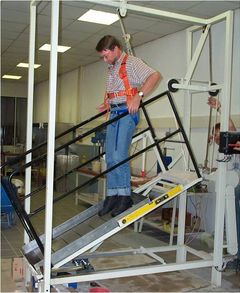Antislip Standards - Online
WHAT DOES THE LAW SAY?
The only reference to antislip requirements in the Building code is section D - Accessways, specifically D1.3.3. However, a recent rewrite of D1/AS1 which is the publication of Acceptable Solutions to ensure compliance with Section D covers a wider scope than just accessways particularly for commercial situations.
D1/AS1 now refers to both Pendulum testing (SRV not less than 39) as well as Ramp testing which provides an R value (R9, R10, R11). The two testing methods are quite different and the result of one does not corelate to the other. As tile importers we can generally provide one or the other for an antislip tile, Italian factories for example focus on the ramp test method.
WHERE DO YOU NEED AN ANTISLIP FLOOR TILE?
DOMESTIC SITUATIONS:
Accessways: Only the approach to the main entrance and not inside the house. A Pendulum test rating of 39 or higher or a ramp test rating of R11 is required. (ref D1/AS1 2.1.2).
Living areas, Bathrooms & Kitchens:Considered dry under normal circumstances. No slip rating is required. (ref 2.1.2)
Swimming pools surround: The immediate pool surround requires a Pendulum W (over 45) or R11. This is a recommendation only.
External paths, patios, verandahs etc: No guidance given but refer to table 3B from HB 198 (below). We recommend R11 or Pendulum W (over 45) (Ref Table 3B)
Sloping access including stairs: Calculate based on slope as per Appendix F, AS4586. (ref D1/AS1 2.1.5)
COMMERCIAL SITUATIONS:
Accessways expected to become wet during normal use: The approach to and transition zone into a public building requires a 39 Pendulum test or R11 ramp test rating. Internally this can be achieved by providing a mat of at least 1.8mtrs length, if an antislip tile is not used. (ref D1/AS1 2.1.6)
Sloping access including stairs: ref D1/AS1 2.1.5. As per domestic criteria.
Other Commercial Situations: ref D1/AS1 2.1.4. We recommend using Table 3B from HB198 (below) for appropriate pendulum or R rating. This is a valuable resource for tile specifiers and we encourage our staff and clients to use this as a reference for any commercial project.
TABLE 3B HB198
PEDESTRIAN FLOORING SELECTION GUIDE - MINIMUM PENDULUM OR RAMP RECOMMENDATIONS FOR SPECIFIC LOCATIONS

Other considerations include the amount and type of traffic expected, the product characteristics, exposure to contaminants, environmental factors, management policy and maintenance practices, OSH requirements, special provisions (i.e. handrails) and alternative information sources (warning signs).
SO WHAT ARE THESE TESTING METHODS?
PENDULUM SLIP TEST (WET AND DRY)
The pendulum slip test is portable and consists of a weighted foot with a test slider that swings down and slides across the surface wetted with water. The weighted foot comprises a spring loaded rubber test slider that exerts a prescribed force over the specimen as it slides across the surface.
While there are 2 rubber slider materials that may be used, Slider 96 (Four S - simulated standard shoe sole) is generally accepted as the material to assess the slip resistance for the general public wearing suitable footwear. Slider 55 TRL (Transport Research Laboratory) rubber is predominantly used for highly slip resistant and profiled surfaces. Research has indicated that TRL rubber may provide a better indication of barefoot slip resistance due to the softer yielding nature of the material, being more comparable to human skin than Four S rubber. The readings and correlating classification are shown below:

THE RAMP TEST
The Ramp Test involves a subject walking across the tiles under scrutiny, which are in turn fixed to an adjustable ramp. The subject wears specified safety footwear, and the surface of the tiles are covered in an oil. The angle of the ramp is increased until the subject can no longer maintain balance, and at this point the angle of the ramp is recorded.
The steeper the angle, the higher the slip resistance, and the higher the score. The tile is awarded an “R – rating” between 9 and 13 inclusive, with the higher rating indicative of higher resistance. The below table shows possible suggested applications for tiles in each rating. Note that the lowest score possible is 9.
One of the disadvantages of this procedure over any other is that it needs to be carried out in a laboratory. Often situations arise, perhaps where there's been an accident or a claim, where measurements need to be taken after installation. Clearly this ramp test is of no benefit in these circumstances.
The small number of different scores is often criticised as a weakness, with each rating covering a relatively wide spectrum of resistance. Having said that, the ramp test results are extremely consistent and are therefore very reliable.
 Our ramp test in action.
Our ramp test in action.


